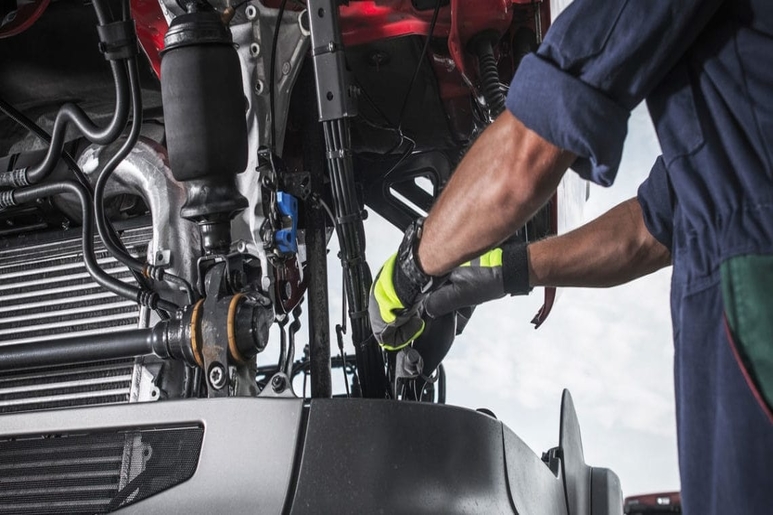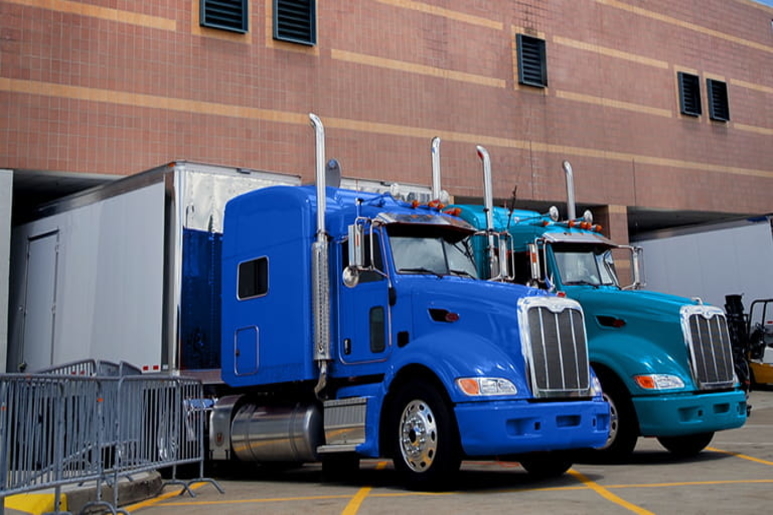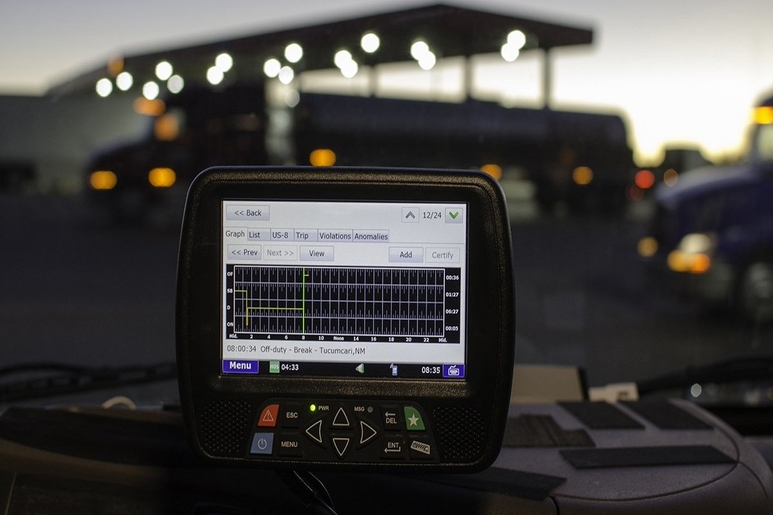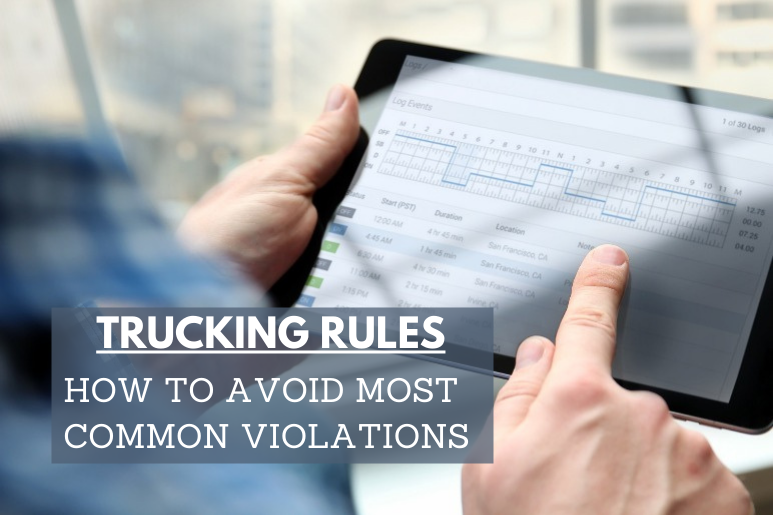Trucking Rules – How To Avoid Most Common Violations
Providing safe highways has been and always will be a priority.
Road safety is essential to the comfort of people and societies.
It is also vital for economic development and prosperity.
Transportation is a complex and seriously regulated industry.
Violations can range from minor mistakes to out-of-service penalty.
Not only do these violations affect the HOS safety score, fines can often be very pricey.
TRUCKING RULES
HOS REGULATIONS
“Hours of service” states to the maximum amount of time drivers are allowed to be on duty as well as driving time.
Most commercial motor vehicle (CMV) drivers must fulfil this rule:
- Vehicle weighs 10,001 pounds or more
- Has a gross vehicle weight rating or gross combination weight rating of 10,001 pounds or more
- It`s designed or used to transport 16 or more passengers (including the driver) not for compensation
- Designed or used to transport 9 or more passengers (including the driver) for compensation
- Transports hazardous materials in a quantity requiring placards
Some of the Hours of Service rules that all drivers need to be mindful of:
1. The 14-hour rule
The driver is not allowed to drive beyond the 14th consecutive hour after coming on duty.
The truck driver can’t continue driving unless he/she has taken 10 consecutive hours off-duty.
The limit is 15 cumulative hours for passenger-carrying vehicles.
2. The 11-hour rule
The 11-hour rule states that within the 14-hour window, a property-carrying driver can drive an all-out of 11 hours after 10 consecutive hours off duty.
Exceptions:
- During hostile weather conditions, the 11-hour driving limit can be prolonged by two hours.
- If emergency relief orders have been declared at a national, regional, or state level.
3. The 30-Minute Break
After a 10-hour off-duty period, drivers can’t exceed 8 hours of driving time without a break of 30 uninterrupted minutes.
Non-driving tasks similar to stopping for gas, doing a pre-trip check, or doing paperwork can be well-thought-out as a part of the 30-minute break.
4. The 60/70-Hour Rule
A driver may not drive after 60 hours on duty in 7 consecutive days, applicable for carriers that do not operate every day of the week, or 70 hours on duty in 8 consecutive days, for carriers that do operate every day of the week.

MAINTENANCE RULES
The FMCSA’s maintenance standards have to make that the trucks are safe to operate.
Every truck needs appropriate maintenance on their lighting, brakes, tires, and other systems.
In addition, carriers have to ensure that each motor vehicle subject to a carrier’s control is properly lubricated and free of oil and gas leaks.
Brakes must be checked and kept in safe and proper working order.
Driver training helps the drivers to recognize brake issues before the brakes fail.
Tires wear down quickly with the volume of driving trucks do.
Preventative maintenance is a great way to keep the truck and equipment acceptable and running smooth.

LOADING RULES
OSHA regulations govern the safety and health of the workers and the responsibilities of employers.
Their safety is ensured at the warehouse, dock, and in other places truckers go to deliver and pick up loads throughout the country.
In this regulation, there is a limit for the large trucks.
Their total weight should be no more than 80,000 pounds for interstate travel.
Violating this makes trucks too heavy to stop or maneuver correctly.
There is also a standard for loading and unloading.
Safe procedures should be followed according to the material that is handled.
If the trailer is unevenly loaded, controlling the vehicle can become a very difficult task.
If a truck fishtails, the entire trailer could fold against the cab in a “jackknife” accident.
Swerving and unbalanced trailers can also flip or smash into cars driving next to the truck.
While hauling a cargo at open flat beds, using a proper tie-down and other devices guarantee the cargo won`t be dropped at the highway.
Most shippers and receivers have a 2-hour window to load/unload a truck.
Any time spent outside of the selected two hours is detention.

HIRING RULES
The trucking and freight business is highly regulated in every aspect.
The obligation of trucking companies is to make background checks on every applicant.
Drivers must meet some requirements before they start their truck driving career.
First, they need to obtain CDL license.
Then valid medical examination cards, and keep them up to date.
Having that they can prove that are medically appropriate to drive.
It is illegal to hire drivers who have poor driving histories, a record of DUI/DWI, or other problems that may make them unsafe.
Also, if a driver fails a drug test, he is no longer allowed to drive.
Poor drivers record can lead to serious accidents on the road.

FMCSA NEW RULES
Short haul exception
Extending from 12 to 14 hours and from 100 to 150 air-miles.
Short haul drivers must operate within a 150 air-mile radius.
They need to start/end duty period at same reporting location.
Maximum duty period is 14 hours.
While operating under the short-haul exception, drivers are not obligatory to fill out a log with a graph grid or use an Electronic Logging Device (ELD).
They can use a time record instead.
Adverse Driving Conditions Exception
Drivers can prolong duty day and driving time by up to 2 hours when adverse driving conditions are met.
Adverse driving conditions means snow, ice, sleet, fog, or other adverse weather conditions or unusual road or traffic conditions that were not known by the driver or carrier prior beginning the duty day.
30-Minute Break Requirement
30-consecutive-minute break is required after 8 cumulative hours of driving without at least a 30-minute break.

Sleeper Berth Provision
Allows drivers to split 10-hour off-duty period, as long as:
- One off-duty period (whether in or out of the sleeper berth) is at least 2 hours long, and
- The other involves at least 7 consecutive hours in the sleeper berth
- Added together, the periods must total at least 10 hours

WHAT ARE THE PENALTIES FOR VIOLATION OF THE RULES ?
Violation in any of the DOT standards established in different areas can lead to serious consequences.
Violators are topic to sanctions that can include financial penalties, suspension of a company’s authorization to function its commercial vehicle fleet, or jail time.
-
HOS VIOLATIONS
If there is a violation of HOS rules, the truck can be shut down.
That means that the truck will sit on the roadside until the driver gathers sufficient off-duty time to be back in compliance.
Law enforcement officers may calculate fines according to state law. These fines on the driver or the carrier range anywhere from $1,000 to $16,000 per violation.
The highest penalties involve hazardous materials where the fine can exceed $75,000.
If a driver operates past 14 hours on duty the average fine for this violation is $7,322.
Violating the over 60/70 hours in 7/8 days rule is a critical violation with a fine of $4,787.
If there is no record of duty status the maximum penalty is $1,270 per day, up to $12,695.

-
FRAUDULENT LOG-BOOKS
Falsifying logs can put drivers out-of-service.
The most common are: not using ELDs when required; falsified records and drivers not sending in logs.
Meaningfully falsifying records might lead to a penalty of up to $12,695.

-
WRONG CLASS LICENSE
Wrong class license is a violation that is more frequent than many people even think of.
During the International Roadcheck 2018, 21.4% of drivers were placed out of service.
Fines may be up to $5,732.
A lot of newcomers in the trucking industry are in look out for training and proper education.
The right trucking school can help choose the right license for a professional trucking career.

-
IMPROPER VEHICLE MAINTENANCE
Broken lighting on the truck is a “visible” violation.
Out of 2.4 million inspections, 28% had problem with broken light or reflective material.
A broken or missing light, reflector, or reflective tape is a loss of six points in CSA for each violation.
Last year there was a registration of over 1 million brake violations. Cost of each one is with four CSA points.
11% of all violations are for tires.
Tires should have 4/32 inch of tread depth; other tires must have 2/32 inch.

-
USE OF DRUGS AND ALCOHOL
Truck drivers are prohibited of using alcohol or drugs.
If a commercial driver causes an accident and injury for the reason that he or she was driving while under the influence of drugs or alcohol, courts will penalize the driver and the company that hired them.
That`s why a negative drug test is mandatory before the hiring process.

-
MEDICAL ISSUES
One in eight driver violations is linked to medical issues.
By regulation, specific medically disqualifying conditions are hearing loss, vision loss, epilepsy and diabetes with insulin use.
Not having a valid medical certificate is a most common medical issue.
That brings a low CSA point value of one or two.
Operating the truck while being physically ill is a 10-point violation.

-
DRIVERS ENGLISH ABILITY
FMCSA regulations require drivers to speak English well enough to understand the signs, make reports, answer to official inquiries and hold a conversation.
-
SPEED
Sometimes drivers have the pressure to deliver on time so the only choice they have is to increase the speed.
Surpassing the speed limit by 15 or more miles per hour in a commercial motor vehicle (CMV) is a serious violation in all states.
The carrier’s safety ranking can be downgraded for a pattern of violations if this occurs.

HOW TO AVOID MOST COMMON VIOLATIONS OF TRUCKING RULES?
The best way to avoid costly penalties is to simply know the rules.
The ELD device can help because it can inform drivers of upcoming violations.
Some other tips can also prevent violations:
- Copy of the current FMCSA rules in the office
It is also very accurate to provide each driver with a copy of the rules.
- Well trained drivers.
Without proper training and orientation, a timeliness of traffic stops can be an issue.
- Complete pre-trip and post-trip inspections of the trucks with a valid documentation.
- Maintain a safety history of each driver following with a record of HOS that are registered with ELD.
- Keep a record of any road incidents for each vehicle
- Ensure that each vehicle has its DOT registration number.
CONCLUSION
Certainly, there are countless safe truck drivers who follow the rules of the road.
But for the ones who don`t, DOT violations can have significant consequences.
Trucking companies can reduce their violation risk by taking simple steps to improve their actions in the main areas: Hiring, safety, vehicle health, and compliance.



